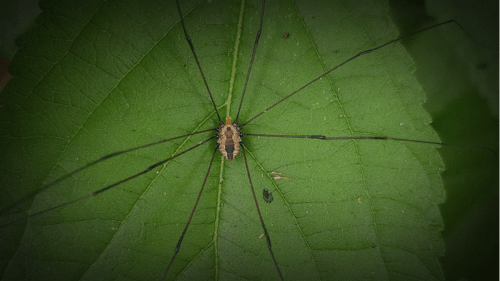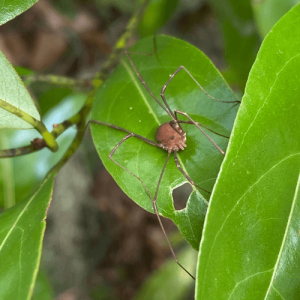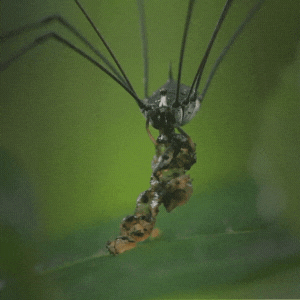
As our community continues to recover from recent storms, find helpful resources and information at tiny.cc/ufsaraext_disasterprep, tiny.cc/saraco_disasterprep, and scgov.net/government/emergency-services/storm.
This blog is part of a multi-part series. To meet other members of “The Spooky Bug Brigade,” visit our blog’s landing page.
Harvestmen (Opiliones)

Credit: © Liodytes Aleni, some rights reserved
Description

Credit: © Abby H, some rights reserved
Now, those long legs belong to none other than the “daddy longlegs,” or harvestman. You may have once heard the popular myth that these “spiders” have some of the deadliest venom worldwide…but their mouthparts are simply too small to bite humans. Well, I am here to say nay – these non-spiders are a non-issue, as they don’t even produce any venom.
Although closely related to spiders, harvestmen are a different order of arachnids. Like their relatives, they have two main body segments: the cephalothorax and abdomen. However, there is less definition between these two segments in harvestmen, so their body appears to be a singular unit. Another difference that sets harvestmen apart from many other arachnids is their number of eyes. They only possess two, located at the front center of their head. Unlike whip scorpions and whip spiders, their pedipalps are relatively short and remain close to their body.
Harvestmen tend to come in an earthy color palette, with several species sporting brown, orange, and black bodies. This allows them to blend in with their surroundings, camouflaging from predators. If threatened, they engage in a unique “bobbing behavior,” vibrating at a rapid pace to avoid being caught. To detect predators and prey alike, they use their second pair of legs to sense their environment through vibrational cues.
Services

Credit: lavoview from Getty Images Signature; designed in Canva
Speaking of prey, harvestmen are another member of the “spooky bug brigade” that helps keep insect populations in check. They do not discriminate between the living and the dead. Both are succulent snacks for the harvestmen. Because they don’t have the ability to inject venom, they rely on their pedipalps and mouthparts to grab, tear apart, and chew their food.
Harvestmen are generalist feeders, meaning that they eat a wide variety of bugs. However, given their relative size, they tend to focus on small, soft-bodied insects, including common garden pests like aphids, psyllids, mites, and small caterpillars. Beyond providing free pest control services, they also serve as food for wildlife, such as birds, lizards, and larger invertebrates.
Habitat
They can be seen on structures, trees and shrubs, and under rocks and mulch. Although mostly solitary, some species of harvestmen will occasionally aggregate in large numbers. It is thought that they do this to retain their body’s moisture content, defend against predation, and assist in successful mating.
These harmless arachnids are prone to desiccation. Consider leaving a small, shallow dish of water in your yard to help them stay hydrated. Adding stones or pebbles can help fill out the dish and prevent accidental drowning. Make sure to periodically empty and clean your dish to prevent breeding mosquitoes.
Fun Fact
Harvestmen are an ancient lineage with fossil evidence of their existence dating back to 400 million years ago. During this time, they’ve evolved some interesting survival strategies. Learn more in the video below!
Read more about these misunderstood arachnids here.
Resources
- UF/IFAS Featured Creatures: https://entnemdept.ufl.edu/creatures/
- UF/IFAS Insect ID Lab: https://entnemdept.ufl.edu/insectid/
- IPM Florida: https://ipm.ifas.ufl.edu/
- UF/IFAS Extension Sarasota County, Chemicals in the Environment: https://sfyl.ifas.ufl.edu/sarasota/natural-resources/chemicals-in-the-environment/
Credits
- Featured image: Cristina Carrizosa, UF/IFAS
- Photos: Credited in caption
- Graphics: Designed in Canva
 2
2
